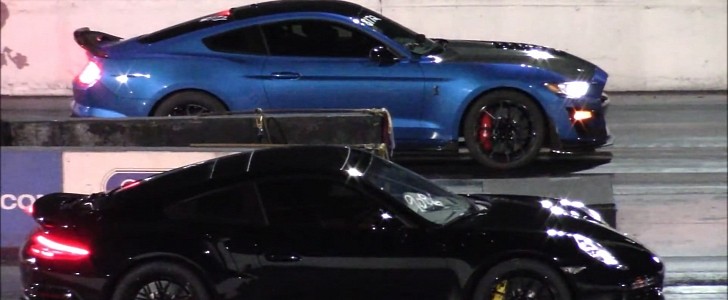From the factory, the Shelby GT500 is an impressive strip slayer. But with a few serious modifications to the drivetrain and a set of sticky radials, you can easily break into the 9s as opposed to 10.7 seconds fully stock.
Heaven only knows what kind of mods the blue-painted car in the following video hides under the skin, but it has utterly demolished another Shelby GT500 on the strip. It I were to guesstimate, the slitherin' serpent is probably packing more than 1,000 horsepower and an upgraded clutch pack for the dual-clutch transmission to support the higher torque rating.
Filmed by Drag Racing and Car Stuff at the Palm Beach International Raceway, the race ends in 9.7 seconds at 149 miles per hour (239.8 kph) while the stock sibling crosses the line in 10.6 seconds at 141 miles per hour (226.9 kph). Against a tuned Dodge Challenger SRT Hellcat, the time slips are pretty darn close at 9.8 versus 9.9 seconds at 149 and 141.5 miles per hour (239.8 and 227.7 kph), respectively.
The third contender, coming in the form of a modified fifth-generation Civic with drag radials, couldn’t stand a chance either. Across the finish line, the Shelby GT500 takes the win in 9.6 seconds at 148.6 mph (239.1 kph) while the old-timer Japanese hatch couldn’t do better than 12.2 seconds at 109.1 mph (175.6 kph). The ‘Stang improved to 9.51 seconds on the fourth run against a fourth-generation Camaro, which is hugely impressive for a street-legal car.
On the final race, the protagonist dukes it out against a 991.2 Porsche 911 Turbo S with standard rubber shoes. Even though it has a very smart AWD system and a world-class launch control system, the German sports car finished in 10.10 versus 9.59 seconds for the American muscle car.
Bear in mind, however, that tuning the Shelby GT500 does come with a couple of risks. For starters, the Blue Oval is going to void the warranty if you upgrade the supercharger pulley or fuel injectors for bigger bangs. Secondly, increasing suck-squeeze-bang-blow while keeping the internals stock is a recipe for disaster, as you already know from vlogger StangMode.
To make a long story short, his Shelby GT500 blew up on wide-open throttle. After the teardown, StangMode found out that a connecting rod is what punched two holes through the block while the other rods were all bent.
Filmed by Drag Racing and Car Stuff at the Palm Beach International Raceway, the race ends in 9.7 seconds at 149 miles per hour (239.8 kph) while the stock sibling crosses the line in 10.6 seconds at 141 miles per hour (226.9 kph). Against a tuned Dodge Challenger SRT Hellcat, the time slips are pretty darn close at 9.8 versus 9.9 seconds at 149 and 141.5 miles per hour (239.8 and 227.7 kph), respectively.
The third contender, coming in the form of a modified fifth-generation Civic with drag radials, couldn’t stand a chance either. Across the finish line, the Shelby GT500 takes the win in 9.6 seconds at 148.6 mph (239.1 kph) while the old-timer Japanese hatch couldn’t do better than 12.2 seconds at 109.1 mph (175.6 kph). The ‘Stang improved to 9.51 seconds on the fourth run against a fourth-generation Camaro, which is hugely impressive for a street-legal car.
On the final race, the protagonist dukes it out against a 991.2 Porsche 911 Turbo S with standard rubber shoes. Even though it has a very smart AWD system and a world-class launch control system, the German sports car finished in 10.10 versus 9.59 seconds for the American muscle car.
Bear in mind, however, that tuning the Shelby GT500 does come with a couple of risks. For starters, the Blue Oval is going to void the warranty if you upgrade the supercharger pulley or fuel injectors for bigger bangs. Secondly, increasing suck-squeeze-bang-blow while keeping the internals stock is a recipe for disaster, as you already know from vlogger StangMode.
To make a long story short, his Shelby GT500 blew up on wide-open throttle. After the teardown, StangMode found out that a connecting rod is what punched two holes through the block while the other rods were all bent.




















